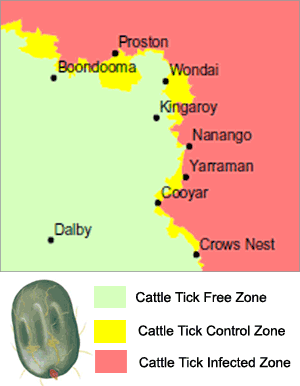
(Map: DPI, Qld Cattle Tick Zones, Dec 2005)
November 29, 2012
A Proston cattle producer who helped re-form the Boondooma Cattle Tick Control Committee has been appointed to a new-look Cattle Tick Management Queensland group (CTMQ) set up by the State Government.
Tom Seiler from ‘Killara’ has been an outspoken advocate for greater tick control efforts from the State Government for most of this year.
In March he help to re-form the Boondooma Committee after a meeting of more than 50 beef producers in the Durong, Boondooma and Brigooda areas met to air their concerns about the increased rates of infected properties being recorded on the clean side of the line, and particularly on properties adjoining the line.
Mr Seiler said beef producers on the tick line were shouldering a heavy cost to keep the southern country clean, and soon afterwards presented a list of demands to the State Government on behalf of the committee’s members.
These included:
- That the tick line on the Weber boundary be put back to where it was originally intended and agreed to by landholders at the time the tick line was gazetted
- That Boondooma Clearing Dip be reinstated to full services – open five days a week with a permanent stock inspector stationed at Boondooma Stock Office
- That penalties be enforced for stock encroaching from either side of the buffer zone in areas where there is a clear tick line buffer zone
- That the Queensland Government resume its responsibility as the legal authority in maintaining the integrity of the tick line and the inspection of stock and discontinue the practice of having biosecurity zones where producers do their own inspections and treatments, and
- That the Government increase the acaricide chemical subsidy for affected producers on the tick line and inside the affected area up to 100 per cent from the existing 10-35 per cent subsidy.
Yesterday Agriculture Minister John McVeigh said the issue of cattle ticks was important.
“I have been visiting regional areas speaking to industry leaders and producers and this issue of cattle ticks keeps coming up. I am committed to addressing the problem,” he said.
“Cattle ticks are the most serious external parasite for Queensland’s livestock industries, and if not managed could potentially spread tick fever.”
Mr McVeigh said that while the state-wide Cattle Tick Management Queensland group has been around since 2006, he was changing its structure to develop proposals jointly with the Department of Agriculture, Fisheries and Forestry for funding strategies and business plans for the whole cattle tick management program.
“The new CTMQ chair Patrick Hick (Julia Creek cattle producer) will also liaise directly with representatives of the dairy and horse industry.”
The new CTMQ members are:
- Tom Seiler, Killara, Proston, Agforce/cattle producer
- Brian Tessmann, President QDO
- Ian Harsant, Oakleigh, Harrisville, Agforce/cattle producer
- Michael McTaggart, Bears Lagoon, Moura, Agforce/cattle producer
- Paul Wright, Taroom, cattle producer/veterinarian
- Peter Hayes, (ALMA/ALPA) Livestock Agent
- Ted Parish, DAFF Queensland.
Mr McVeigh said the group would be a forum for discussion between interest groups and DAFF, and he would look to the group for recommendations on amendments to legislation.
Discussion will focus on:
- Infestations in the Free/Control Zones
- Market access
- Cost of clearing stock from the infected zone
- Acaricide subsidy, and
- Moving horses between zones.
Mr McVeigh said DAFF was committed to maintaining the integrity of the tick line and additional frontline officers had been recruited to step up the fight against ticks.
“Three new cattle tick officers have been recruited in Gatton, Roma and Longreach to work with producers in the cattle tick free areas to eradicate ticks, help with outbreaks and inspect and clear stock moving between cattle tick zones,” he said.
“These appointments are part of the Government’s drive to put 15 new frontline officers to work in regional parts of Queensland.”
- External link: Govt Cutbacks Threaten Integrity Of Tick Line (Beef Central)























